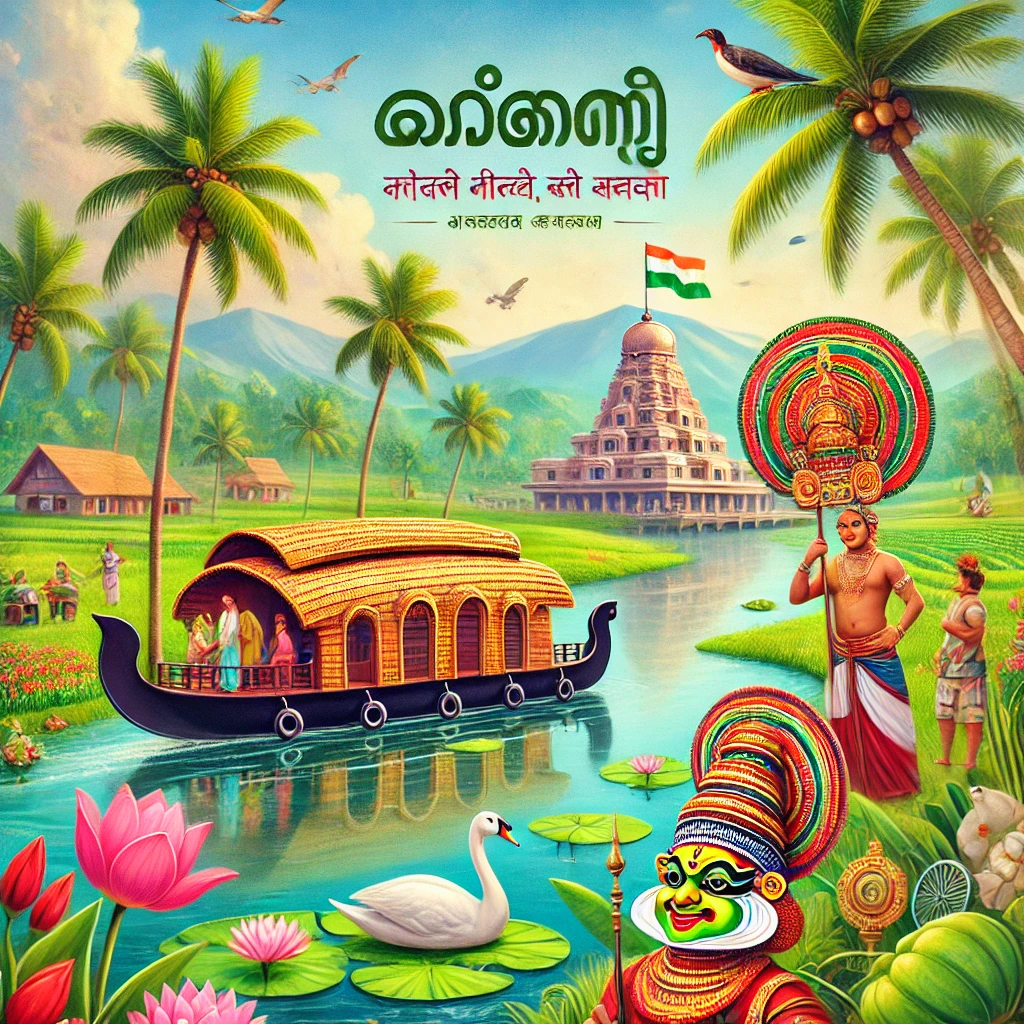
Kerala is a small but prosperous state located in the south – western corner of India . It is known for its natural beauty , cultural heritage , and excellence in social development. It is called ” God’s Own Country ” .
Geographical location and climate
- Location : Kerala is situated between the Arabian Sea in the west and the Western Ghats range in the east.
- Area : 38,863 square kilometres , which is 1.18% of India .
- Number of Districts : There are 14 districts in Kerala , like Thiruvananthapuram , Kochi , Kasaragod , Kozhikode etc.
- Climate : Kerala has a tropical climate , and remains green throughout the year. The region receives heavy rainfall during the monsoon.
History
- Ancient times : The history of Kerala dates back to the ancient Sangam period. The region was known worldwide for its spices. In ancient times, Kerala was a major center for Roman , Arab , and Chinese traders.
- Colonial period : Kerala came to the attention of European powers with the arrival of Vasco da Gama in 1498. The Portuguese , Dutch , and eventually the British ruled here.
- Modern period : Kerala was formed in 1956 on the linguistic basis.
Language and culture
- Language : Malayalam is the main language of Kerala. Apart from this, English and Tamil are also widely spoken.
- Religion : Here we can see a mix of Hindu , Muslim , and Christian communities.
- Cultural heritage :
- Dance : Kathakali , Mohiniyattam , Koodiyattam.
- Music : Sopana music and traditional temple music.
- Festivals : Onam , Vishu , Christmas , and Eid.
- Folktales : Kerala has a rich tradition of folktales and old stories.
Natural Beauty
- Backwaters : The backwaters of Alleppey and Kumarakom are the major attractions of Kerala.
- Beaches : Kovalam , Varkala , Mararikulam.
- Hill stations : Munnar , Wayanad , and Thekkady.
- Wildlife : Silent Valley National Park and Periyar Tiger Reserve.
Economy and industry
- main industries :
- Tourism : Kerala is a major tourist destination of India.
- Production of spices : Black pepper , cardamom , ginger.
- Coconut , rubber , and tea production.
- Other industries : fishing , bamboo handicrafts , and cooperative sector.
Education and health
- Literacy rate : Kerala has a literacy rate of 96% , the highest in India.
- Health Services : Kerala’s public health services and Ayurvedic medical system are internationally renowned.
Tourism
- Main attractions :
- Alleppey Backwater Cruise.
- Jungle Safari of Thekkady.
- Tea Plantations of Munnar.
- Varkala and Kovalam beaches.
- Tourist Features : Houseboats , Ayurvedic Spa , and traditional food.
Features of Kerala
- Onam Festival : This is the main festival of Kerala , which symbolizes harvest and welcoming King Mahabali.
- Traditional Attire : White saree ( Kasavu saree ) for women and mundu for men.
- Food : Sadya ( food served on banana leaf ), coconut-based curries , and seafood.
- Waterways : Kerala has many rivers and lakes , making the state the ” Land of Water ” .
social development
- Kerala leads in its social indicators. Life expectancy , women empowerment , and infant mortality rate are some of the best in India.
conclusion
Kerala is a state where a unique blend of tradition and modernity is seen. Its culture , natural beauty , and lifestyle give it a unique place not only in India but in the whole world.
Geographical location of Kerala
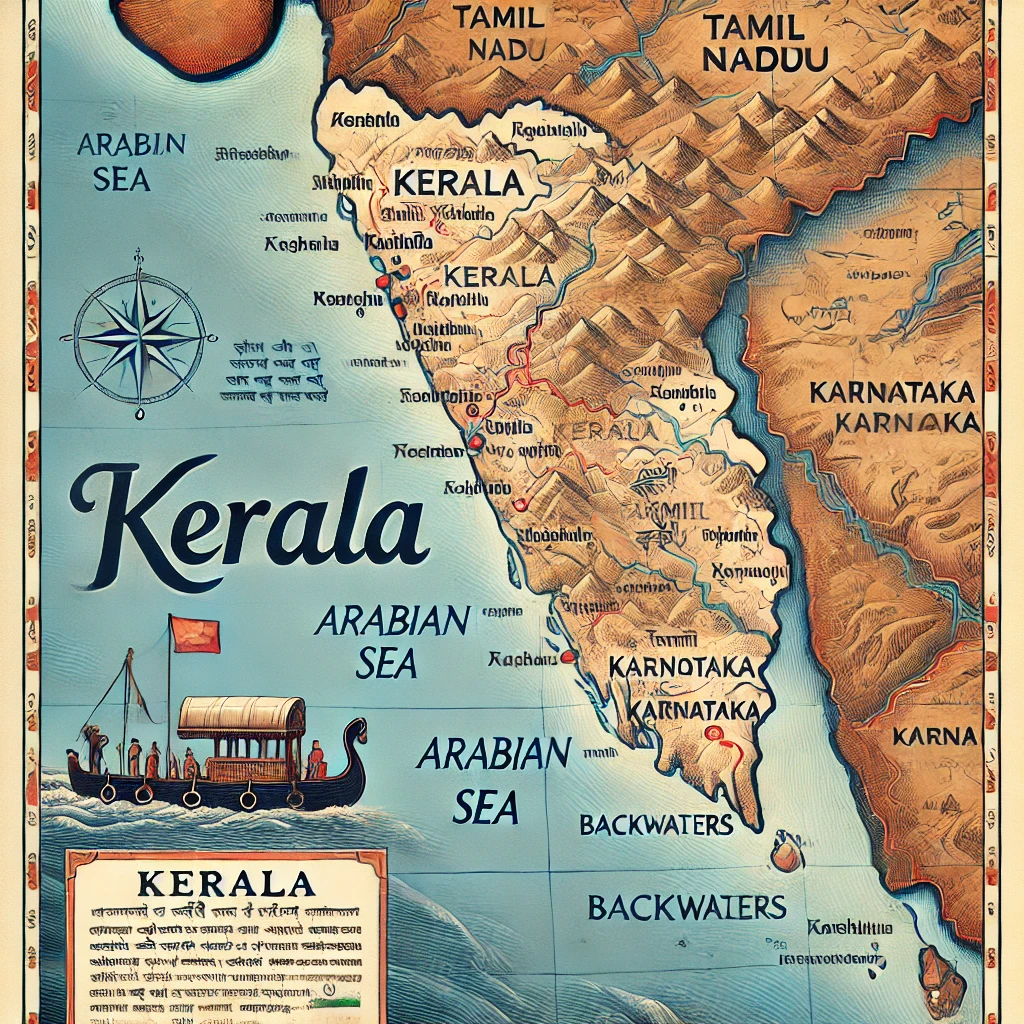
Geographical location of Kerala is a small but geographically diverse state located on the south – western tip of India . The state is known for its unique geographical structure , greenery and natural beauty. Its geographical location gives it a special identity in India and around the world.
Status and limitations
place :
- Kerala is located between 8°18′ North latitude and 12°48′ North latitude and 74°52′ East longitude and 77°22′ East longitude.
- is located on the coast of the Arabian Sea in the south – western corner of India .
Limitations :
- North and north – east : Karnataka state.
- East : Tamil Nadu State.
- West : Arabian Sea.
- South : Southern end with Kanyakumari , Tamil Nadu.
Beach :
- The coastline of Kerala is approximately 590 kilometres long.
- This coastal region has a rich array of ports and beaches , such as Kovalam , Varkala , and Mararikulam.
geographical structure
The physiographic structure of Kerala is divided into three major regions :
Western Ghats ( Mountainous Region ) :
- The eastern part of the state is surrounded by the Western Ghats range , which rises from about 1,500 metres to 2,695 metres in height.
- The region contains major hill stations and wildlife sanctuaries.
- Important peaks :
- Anaimudi (2,695 m ), the highest peak in South India.
- Agasthyarkoodam and Mekurthi.
- The region is the source of the major rivers of Kerala.
Central Plains ( valleys and plateaus ) :
- The region is situated between the Western Ghats and the coastal area.
- There is fertile land here for farming and gardening.
- is famous for plantations of spices , rubber , tea , and coffee.
Coastal area ( sea plain ) :
- This is the western part , which spreads along the Arabian Sea.
- Coconut groves , rice fields , and backwaters ( lakes and canals ) are found in the region.
- The backwaters are a major attraction in areas like Alleppey and Kumarakom.
Major rivers and lakes
Kerala has 44 rivers , most of which flow westward and drain into the Arabian Sea.
- Important Rivers :
- Periyar (244 km , the longest river in Kerala ) .
- Bharathapuzha.
- Chaliyar.
- Pumbaa.
- Kadalundi.
- are important for agriculture , transportation , and hydroelectricity production.
- Important Rivers :
Lakes :
- Vembanad Lake : The largest lake in Kerala.
- Ashtamudi Lake.
- Kayal Lake.
- These lakes are the main centre of tourism and local transportation.
Soil and vegetation
Soil :
- Kerala has a variety of soil types , such as red soil , laterite soil , and coastal sandy soil.
- is suitable for cultivation of crops like paddy , spices , and rubber.
Vegetation :
- 30% of Kerala is covered with dense forests.
- The Western Ghats region is dominated by evergreen forests.
- Wildlife : Elephants , tigers , rhinoceroses , and rare species of birds.
climate
- Type :
- Tropical monsoon climate.
- Rain :
- Rainfall is received from the south – west and north – east monsoons.
- The average annual rainfall is around 3,000 mm.
- temperature :
- 20°C to 37°C in summer and 18°C to 32°C in winter .
Geographical Importance
- Agriculture :
- Suitable for cultivation of paddy , coconut , tea , coffee , rubber , and spices.
- Tourism :
- It is a major tourist destination due to its backwaters , beaches , hill stations , and wildlife sanctuaries.
- Business :
- Kerala’s geographical location makes it the hub of India’s spice trade.
- Kochi Port is a major port of India.
The geographical location and natural diversity of Kerala make it a unique state. Its geographical features not only help in the economic and cultural development of the state , but also give it a prominent place on the global map.
History of Kerala
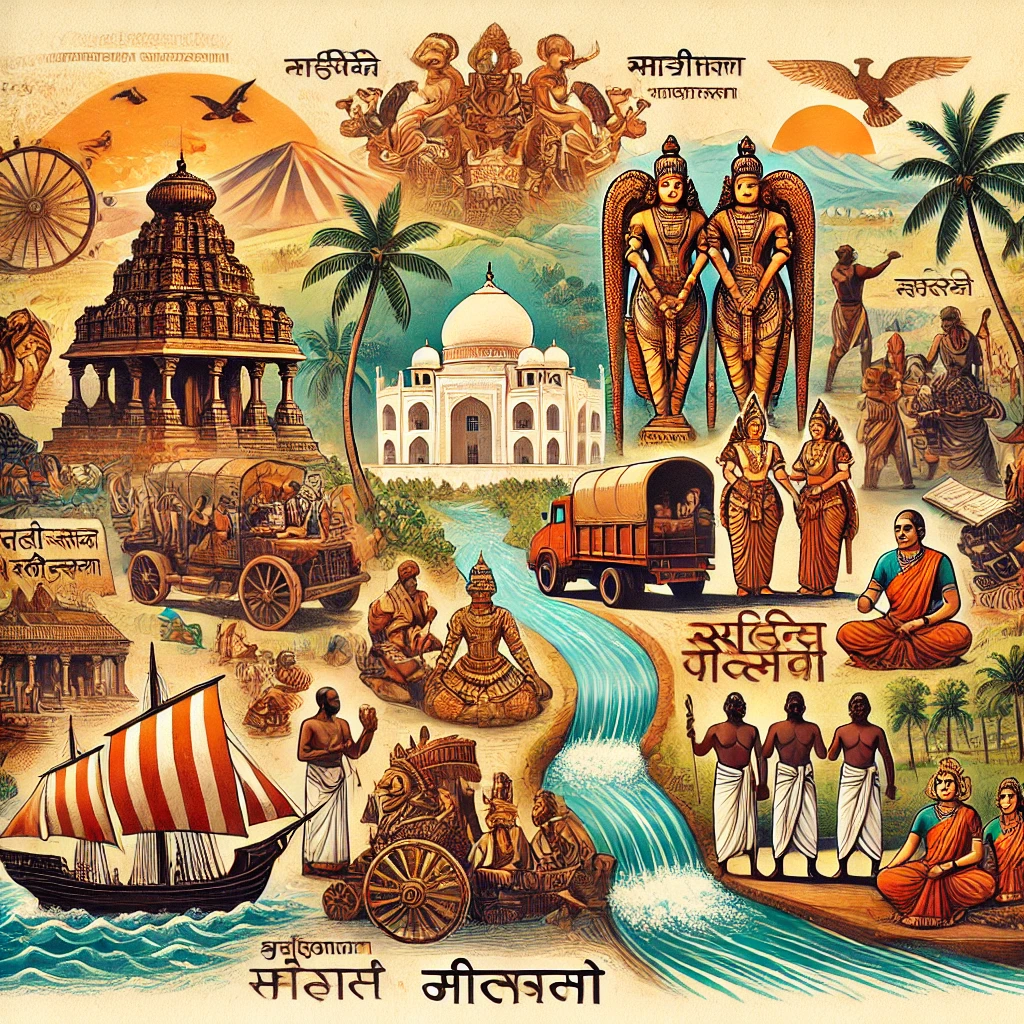
The history of Kerala is rich with ancient civilisations , cultural heritages, and social reforms. The region has been a centre of trade , art , and religious activities since ancient times. It has seen various rulers , foreign influences , and social movements that led to the development of modern Kerala.
Ancient period
1. Mythological stories
- The name Kerala is believed to be derived from ” Ksheeralam ” ( coconut land ) .
- According to a popular legend , this land was taken out of the ocean by Lord Parashurama.
- Parashurama pushed back the sea with his axe and it became fertile land.
2. Initial residence
- Evidence of human settlement in Kerala dates back to Stone Age It is available till.
- Ancient dolmen and pottery archaeological sites provide evidence of this.
3. Sangam Age (300 BC – 300 AD )
- is the time of ” Sangam literature ” of Tamil literature .
- Kerala is mentioned as ” Chera land ” in Sangam literature.
- Chera Dynasty :
- This was the time of the Chera kings , who ruled over Kerala and parts of Tamil Nadu.
- The Chera dynasty played an important role in the trade of spices and other goods.
4. Trade and foreign contacts
- Kerala has been a major centre of trade since ancient times.
- Ancient Roman , Greek , Arab , and Phoenician traders came here to buy spices , silk , and sandalwood.
- Muziris :
- Ancient port city of Kerala , now believed to be near ” Kodungallur ” .
- It was famous for trade and had trade relations with the Roman Empire.
Medieval period
1. Resurgence of the Chera Empire (9th – 12th century )
- The Second Chera Empire ruled Kerala from the 9th to the 12th centuries.
- Important Rulers :
- Kulasekhara Varman.
- Kulasekhara Alvar contributed to the Bhakti movement.
2. Bhakti movement and temple culture
- The Bhakti movement had a profound impact on Kerala.
- Several temples such as the Padmanabhaswamy Temple and the Guruvayur Temple were established at this time.
- Along with temples, art and architecture also developed.
3. Foreign influence
Arab and Chinese traders :
- Entry of Islam and Christianity into Kerala.
- Islam and Judaism spread through Arab traders.
Arrival of Christianity :
- Christianity came to Kerala with the arrival of St. Thomas in the 1st century.
- It is one of the oldest centres of Christianity in India.
Importance of Calicut :
- Calicut ( Kozhikode ) became a major port for the spice trade.
Modern period
1. European colonialism
Portuguese influence :
- 1498 Vasco da Gama discovered the sea route to India by reaching the port of Calicut.
- The Portuguese captured the spice trade here.
Dutch and British :
- Dutch and British traders also reached Kerala in the 17th century .
- The Dutch defeated the Portuguese and traded here for some time.
- The British East India Company assumed control of parts of Kerala in the 18th century .
2. Indigenous rulers
- The two major princely states were Travancore and Cochin.
- Travancore was ruled under Maharaja Marthanda Varma (1729–1758) , who expanded and organised the kingdom.
- The kingdom of Cochin was also a centre of trade and administration.
3. Social reform movement
- The 19th and 20th centuries saw social reform movements in Kerala.
- Narayana Guru :
- Movement against casteism and social discrimination.
- Message of ‘ one caste , one religion , one God ‘ .
- Ayyankali :
- Worked for Dalit upliftment.
- Vaikam Satyagraha (1924-25) :
- Satyagraha against temple entry and caste discrimination.
Independence movement and formation of Kerala
- Many freedom fighters from Kerala took part in the independence struggle.
- Kerala was formed on 1 November 1956 on the linguistic basis.
- The Travancore , Cochin and Malabar regions together became modern Kerala.
Contemporary Kerala
- After independence, Kerala made major progress in education , health , and social reforms.
- is famous for having the highest Human Development Index (HDI) and literacy rate in India.
conclusion
The history of Kerala is replete with its cultural richness , its role as a trading centre , and social reforms. The state has seen several phases of development from ancient times to modern times. Its rich heritage , art , and social structure make it a unique part of India.
Natural beauty of Kerala
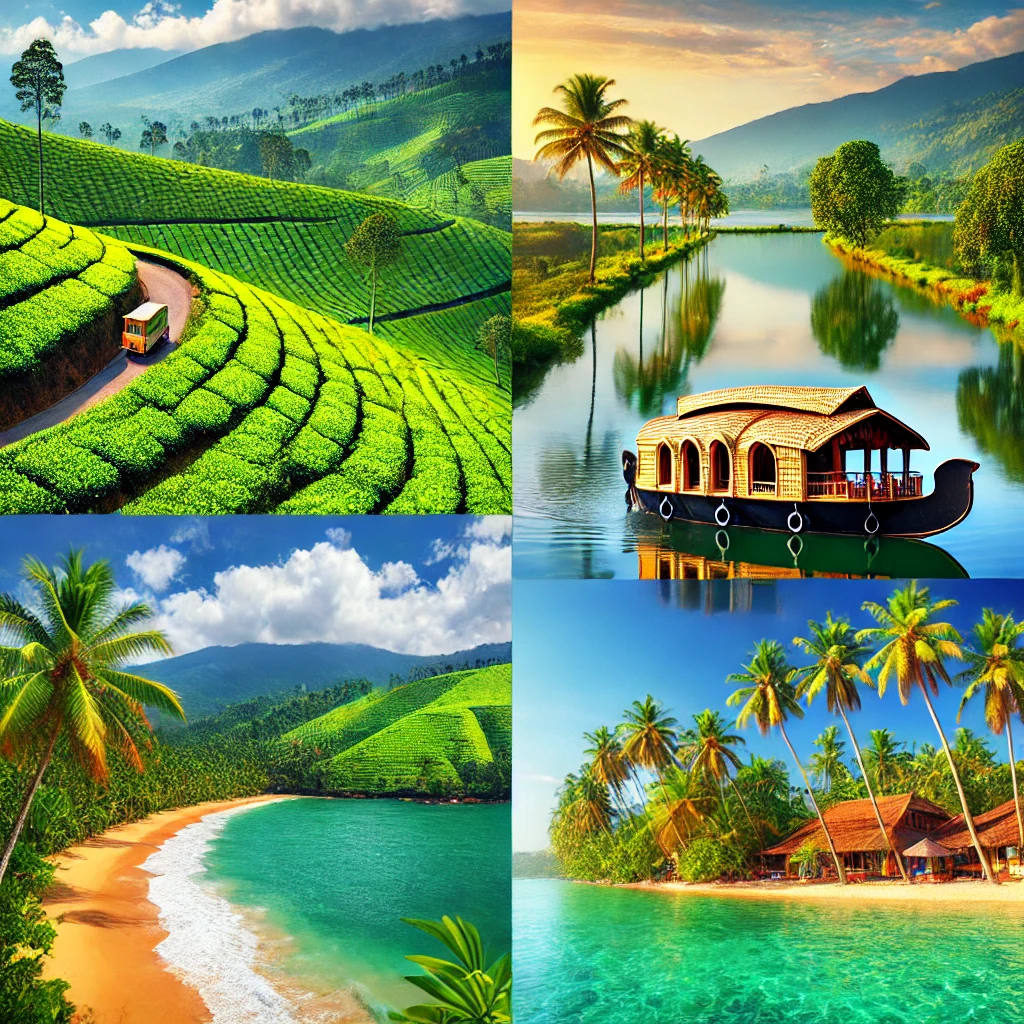
Kerala is famous all over the world for its unique natural diversity and beauty. The greenery , tranquil backwaters , beaches , mountains , and dense forests of this state give it the nickname ” God’s Own Country ” . The natural beauty here not only attracts tourists but it also plays an important role in the economic , cultural and social life of the state.
1. Backwaters
The backwaters of Kerala are a wonderful example of its natural beauty.
- Main backwater areas :
- Alleppey ( Alappuzha ) : It is called the ” Venice of the East ” . Houseboat rides here are popular among tourists.
- Kumarakom : This place is famous for the backwaters as well as the bird sanctuary .
- Kollam and Kottayam .
- can enjoy the shade of coconut trees , calm streams , and traditional rural life.
- The backwaters have been traditionally used for transportation and fisheries.
2. Beaches
The beaches of Kerala symbolize its natural beauty and serenity.
- Major Beaches :
- Kovalam Beach ( Thiruvananthapuram ): It is the most famous beach in Kerala , popular among foreign and domestic tourists.
- Varkala Beach : This beach is known for its unique rocky landscape and Ayurvedic centres.
- Mararikulam Beach : This serene beach is ideal for honeymooners.
- Cherai Beach ( Kochi ): This beach is famous for its clear waters and coconut plantations.
- The view of sunrise and sunset on the beaches is unforgettable.
3. Hill Stations
The hill stations nestled in the mountains of the Western Ghats are an important part of the attractions of Kerala.
- Munnar :
- Famous for tea plantations and cool climate.
- Anaimudi Peak (2,695 m ), the highest peak in South India.
- Eravikulam National Park , famous for the Nilgiri tahr.
- Wayanad :
- This place is known for its dense forests , waterfalls , and ancient caves.
- Edakkal Caves and Banasura Sagar Dam are the major attractions.
- Thekkady :
- Famous for the Periyar Wildlife Sanctuary.
- The area is also surrounded by rubber and spice plantations.
- Ponmudi :
- This hill station is located near Thiruvananthapuram and is famous for its natural landscape and trekking.
4. Forests and Wildlife
30% of Kerala is covered with forest area. The forests of the Western Ghats are rich in biodiversity.
- Major Wildlife Sanctuaries and National Parks :
- Periyar National Park ( Thekkady ): Famous for elephants and tigers.
- Silent Valley National Park : This place is a treasure trove of biodiversity and is home to lion – tailed macaques .
- Wayanad Wildlife Sanctuary : Famous for leopards , bears , and other animals.
- Idukki Wildlife Sanctuary .
- Properties :
- There are tropical evergreen forests here , in which rare plants and herbs are found.
- Elephants , tigers , leopards , and many species of birds can be seen in the forests of Kerala.
5. Lakes and Waterfalls
- Major lakes :
- Vembanad Lake : The largest lake in Kerala.
- Ashtamudi Lake : This lake is located near Kollam and is popular for backwater walks.
- Punalur Lake .
- Major Waterfalls :
- Athirappilly Falls : It is called the ” Niagara of South India ” .
- Vazhachal waterfall .
- Sochittaal Waterfall .
- Meyyaru Falls .
- These waterfalls are at their peak beauty during monsoon.
6. Rural beauty and farmland
- Coconut and Paddy Fields :
- Coconut and paddy cultivation in the rural areas of Kerala presents a pleasing sight to the eyes.
- These farms represent the rural lifestyle of the state.
- Spice plantations :
- cardamom , black pepper , ginger , and cloves are the hallmark of Kerala.
- Idukki and Wayanad are famous for spices.
7. Rivers and Streams
- Kerala has 44 rivers , most of which flow westward and drain into the Arabian Sea.
- Periyar : The longest river in Kerala.
- Bharathapuzha , Pamba , and Chaliyar .
- are important for agriculture , fisheries , and hydroelectric projects.
8. Ayurvedic Centre and Peace
- Kerala’s greenery and serene atmosphere make it ideal for Ayurvedic treatment and yoga.
- The natural places here are a source of inspiration for Ayurvedic treatments.
conclusion
The natural beauty of Kerala is unique in the form of its coastal areas , backwaters , hill stations , and biodiversity. It is not only a paradise for tourists but also the basis of life for the local people. This unique blend of natural resources and beauty gives Kerala a special place across the world.
Economic and social condition of Kerala
Kerala is a progressive state of India, famous for its high literacy rate , advanced health services , and social harmony. Its economy depends mainly on the service sector , agriculture , tourism , and remittances sent by the Indian diaspora . Socially , Kerala has set an example for other states of India in many areas .
Economic situation
1. Economic framework
Kerala’s economy is based on diverse sectors :
Service Sector :
- The service sector contributes the most to Kerala’s economy.
- includes sectors such as education , health , banking , and tourism.
Agriculture and Fisheries :
- Agriculture is a major part of the economy in Kerala.
- Main Crops :
- Coconut , rice , rubber , pepper , cardamom , ginger , and tea.
- Production of spices :
- Kerala is called the ” Spice Garden of India” .
- Fisheries :
- Fishing is the main occupation of the local people in the coastal areas.
- Kerala contributes significantly to India’s total marine fish production.
Industrial Area :
- The state has more light industrial units , such as :
- Bamboo and Coconut Products.
- Rubber and ancillary industries.
- Heavy industries are limited in the state.
- The state has more light industrial units , such as :
Remittances ( migrant money ) :
- Gulf countries contribute significantly to the state’s economy.
- Remittances have increased the per capita income of the state.
2. Tourism industry
- Importance :
- Kerala is one of the major tourist destinations of India.
- is famous for its natural beauty , backwaters , beaches , hill stations , and Ayurvedic treatment.
- Tourist attractions :
- Alleppey Backwaters , Munnar Tea Plantations , Periyar Wildlife Sanctuary , and Kovalam Beach.
- Tourism brings great benefits to the state’s economy and creates employment opportunities.
3. Human Development Index
- Kerala has the highest Human Development Index (HDI) in India It is a state with.
- Main reasons :
- High literacy rate.
- Better health services.
- Economic and social equality.
4. Challenges
- Unemployment :
- The unemployment rate among educated youth in Kerala is high.
- Infrastructure :
- The industrial infrastructure is not developed.
- Overseas dependency :
- The state’s economy is highly dependent on remittances , raising questions about long-term sustainability.
Social status
1. Literacy and education
- Literacy rate :
- Kerala has a literacy rate of 96% , the highest in India.
- Women’s education :
- The literacy rate of women in Kerala is also very high.
- The state has performed excellently in providing education to girls.
- Higher Education :
- , colleges and technical institutes for higher education .
2. Health Services
- Modern and traditional medicine :
- Kerala’s public health system is one of the most impressive in India.
- Ayurvedic medicine and traditional medical practices are quite popular here.
- Achievements :
- Infant mortality rate is the lowest in India.
- Life expectancy is around 75 years , which is the highest in India.
3. Social equality and women empowerment
- Many examples of social equality can be seen in Kerala :
- This state is a leader in the field of women empowerment.
- Women participate equally with men in every field of education , health , and social life.
4. Cultural diversity
- A mixture of different religions and communities can be seen in Kerala :
- Hindu , Muslim , and Christian communities.
- Cultural festivals , such as Onam , Eid , and Christmas , are celebrated with enthusiasm throughout the state.
5. Rural and urban development
- countryside :
- Most of the people of the state live in rural areas.
- Coconut trees , paddy fields , and traditional village houses can be seen here.
- Urbanisation :
- Thiruvananthapuram , Kochi , and Kozhikode are equipped with modern amenities.
6. Diaspora Society
- People from Kerala work extensively in Gulf countries and other international destinations.
- The earnings of these migrants have not only improved the economic condition of the state , but have also had a positive impact on social life.
Specialties of Kerala
- Quality of life :
- The standard of living in Kerala is better than other states of India.
- Social reform movement :
- In Kerala, Narayana Guru , Ayyankali , and other social reformers worked against casteism and social discrimination.
- Environmental awareness :
- Many efforts have been made to conserve the environment and maintain greenery in Kerala.
conclusion
The economic and social status of Kerala makes it one of the most progressive states in India. The state emerges as a model for other states due to its high literacy rate , advanced health services , and rich cultural heritage. However , there are also challenges such as unemployment and lack of industrial development. Despite this , Kerala has succeeded in maintaining its social and economic status.
Specialties of Kerala
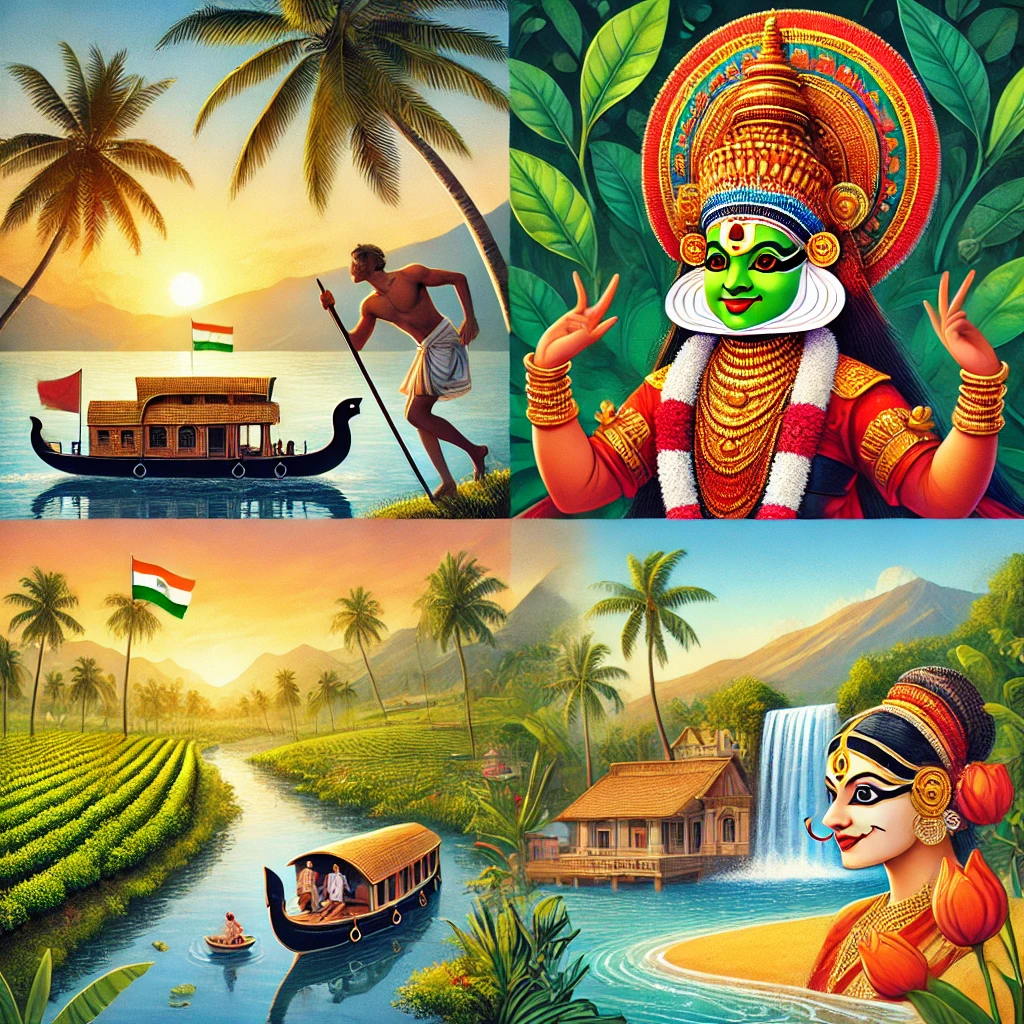
Kerala is called ” God’s Own Country ” , which reflects its unique natural beauty , rich culture , and social progress. The characteristics of this state make it different from other states of India.
1. Natural features
Geographical Diversity :
- Kerala is situated between the mountain range of the Western Ghats and the Arabian Sea.
- Hill stations , backwaters , beaches , and dense forests make it special.
Backwaters and Waterways :
- The tranquil backwaters in areas like Alleppey and Kumarakom are popular with tourists.
beach :
- Beaches like Kovalam , Varkala , and Cherai are the main attractions of the state.
Season :
- Kerala’s tropical monsoon climate is suitable for its greenery and agriculture.
2. Cultural characteristics
Cultural heritage :
- is the centre of classical dance forms like Bharatanatyam , Kathakali , Mohiniyattam.
- , churches and mosques here are important from the architectural point of view.
Festival :
- Onam , Vishu , and Thiruvathira reflect cultural diversity.
- ‘ Payasam ‘ and flower rangoli ( Pookkalam ) are unique in Onam .
Language and Literature :
- Malayalam is the main language of Kerala.
- , Kumaranasan , and Basheer to Malayalam literature is invaluable.
Ayurveda :
- Kerala is the centre of Ayurveda and naturopathy.
- The Ayurvedic treatments and spa here are world famous.
3. Economic characteristics
Production of spices :
- Kerala holds a prominent place in the production of black pepper , cardamom , ginger , and nutmeg.
Agriculture :
- Cultivation of coconut , rice , rubber , and tea forms the basis of the state’s economy.
Tourism :
- its backwaters , hill stations , and beaches.
Remittance :
- NRIs working in Gulf countries contribute significantly to the state’s economy.
4. Social characteristics
Education and Literacy :
- Kerala has the highest literacy rate (96%) in India.
Health Services :
- The region is leading due to its advanced public health system and Ayurvedic medicine.
Women Empowerment :
- Kerala leads in women’s literacy and social participation.
social equality :
- Social reform movements in Kerala have led to a decline in casteism and social discrimination.
5. Characteristics of tourism
Natural beauty :
- The Alleppey backwaters , the tea plantations of Munnar , and the Periyar Wildlife Sanctuary are the highlights.
Traditional Boat Race :
- Events like the Nehru Trophy Boat Race promote tourism.
Local Handicrafts :
- Bamboo , coconut products , and traditional textiles such as Kasavu sarees are famous.
6. Environmental awareness
Green Kerala Campaign :
- There is a special emphasis on greenery and environmental conservation in Kerala.
Biodiversity :
- The Silent Valley National Park and the Periyar Sanctuary reflect the biodiversity here.
conclusion
The characteristics of Kerala make it a unique state not only of India but of the world. Its natural beauty , cultural richness , and social progress give it the status of an ” ideal state ” .
Geographical location and climate of Kerala
Geographical location
1. Location
- is located in the south – western corner of India .
- The state is spread over a narrow strip between the hills of the Western Ghats and the Arabian Sea.
- Latitude and Longitude :
- 8°18′ N to 12°48′ N latitude.
- 74°52′ East to 77°22′ East longitude.
2. Area
- Total area : 38,863 square kilometers.
- is approximately 1.18% of the total geographical area of India .
3. Limitations
- North and North – East : Karnataka.
- East : Tamil Nadu.
- West : Arabian Sea.
- South : Kanyakumari ( part of Tamil Nadu ) .
4. Geographical features
Western Ghats :
- The mountain ranges of the Western Ghats extend across the eastern part of Kerala.
- The region is famous for dense forests , wildlife sanctuaries and tea – coffee plantations.
Plane ( intermediate region ) :
- Spread between the hills and the coastal region, this area is a hub of agriculture and small towns.
Coastal Areas :
- The coastal area stretching along the Arabian Sea is famous for its backwaters and beaches.
- The area is a major centre for fishing and coconut cultivation.
Rivers and lakes :
- 44 rivers in Kerala , of which 41 originate from the Western Ghats and drain into the Arabian Sea.
- Important rivers : Periyar , Bharathapuzha , Pampa , and Chaliyar.
- Lakes : Vembanad Lake , Ashtamudi Lake , and Kayamkulam Lake.
5. The Backwaters
- It is the main geographical feature of Kerala.
- The backwaters are a mixture of freshwater lakes and salt water from the sea.
- The region is important for water transport , fishing and tourism.
6. Flora and wildlife
- 30% of Kerala’s area is forested.
- Tropical evergreen and moist – deciduous forests are found here.
- Important National Parks and Wildlife Sanctuaries :
- Silent Valley National Park.
- Periyar Wildlife Sanctuary.
- Eravikulam National Park.
climate
Kerala is a state with tropical monsoon climate . The weather here remains hot and humid throughout the year.
1. Seasonal Division
Summer ( March to May )
- Temperature : 25°C to 35°C .
- During this time, there is extreme heat in the state , but sea breezes in the coastal areas moderate the temperature.
South – west monsoon ( June to September )
- This is the time of major rainfall in Kerala.
- Onset of Monsoon : Monsoon arrives first in Kerala.
- Average rainfall : 250-300 cm.
North – east monsoon ( October to November )
- It is also called ” retreating monsoon ” .
- During this period, there is less but effective rainfall.
Winter season ( December to February )
- Temperature : 20°C to 30°C .
- This season is comparatively cool and pleasant.
2. Humidity
- Humidity in Kerala remains high throughout the year ( 70–90% on average ) .
- Humidity levels are higher in coastal areas.
3. Rain
South – west monsoon :
- The monsoon enters Kerala in June.
- It is the main source of rainfall in India.
North – east monsoon :
- The state receives surplus rainfall in October – November.
4. Special climatic effects
Effect of Western Ghats :
- The height of the Western Ghats promotes rainfall and makes it a ” rain – shadow region ” .
Influence of Coastal Zone :
- The winds blowing from the Arabian Sea regulate the weather in the coastal areas.
Natural Disasters :
- Sometimes problems like floods and landslides are seen during monsoon .
Importance of geographical location and climate
Impact on Agriculture :
- Kerala is suitable for agriculture due to monsoon rainfall and fertile soil.
- Main crops : Rice , coconut , rubber , spices ( pepper , cardamom ) .
Impact on tourism :
- Backwaters , beaches , and lush forests attract tourists.
- Monsoon tourism is also popular.
wildlife Reserve :
- Tropical forests and biodiversity help in the environmental balance of the state.
Effects on lifestyle :
- Due to the climate and geographical location, people here depend on coconut , fish and rice based food.
conclusion
Kerala’s geographical location and climate make it ideal for natural beauty , biodiversity , and agricultural production. The balance of coastal and mountainous regions makes it an important center for tourism and wildlife conservation. The monsoon climate and natural wealth contribute to the economic and cultural prosperity of Kerala.